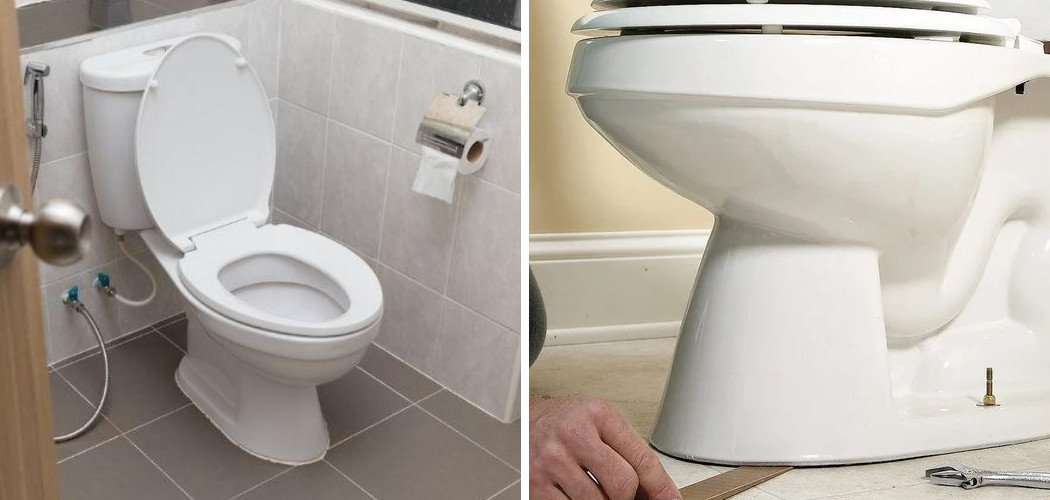Dealing with a sweating toilet can be an annoying and potentially damaging issue in your home. The condensation that forms on the outside of the toilet tank can lead to water damage, mold growth, and slippery floors. Fortunately, fixing a sweating toilet is a manageable task that can be completed with a few simple steps.
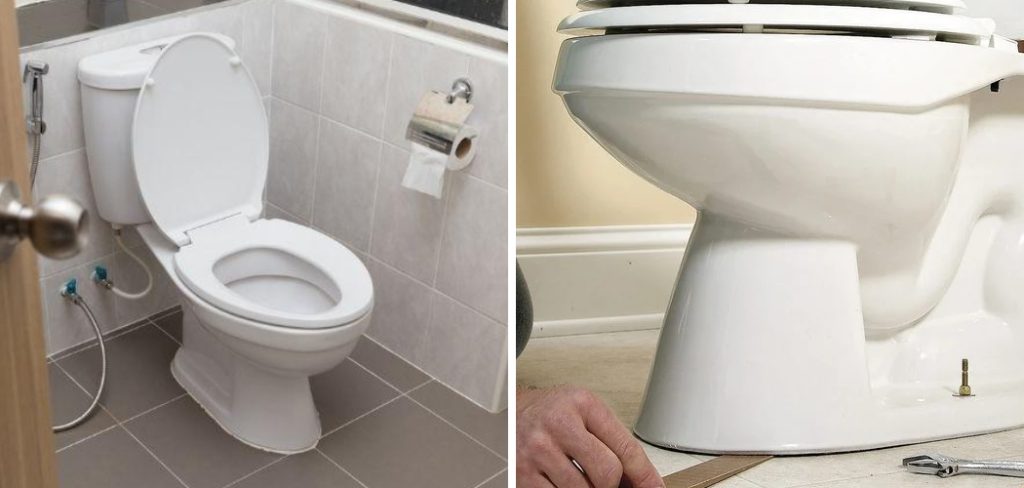
In this article, we’ll explore how to fix a sweating toilet, such as high humidity levels and temperature differentials, and provide practical methods to address the problem effectively. By implementing these solutions, you can prevent moisture buildup, protect your bathroom from damage, and enjoy a comfortable and dry toilet environment once again.
Discomfort Cause by Sweating Toilets
Sweating toilets not only pose a risk to the structural integrity of your bathroom but also create an environment of discomfort and inconvenience. The constant presence of moisture can give rise to a damp and musty atmosphere, making the bathroom less welcoming and even potentially hazardous.
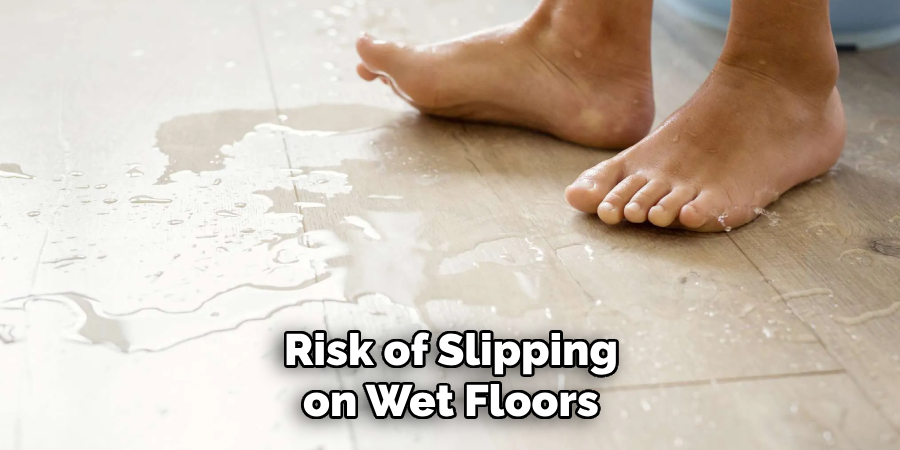
This condition is especially troubling in households with elderly members or children, where the risk of slipping on wet floors increases significantly. Furthermore, the persistent dampness can affect the overall air quality in the bathroom, contributing to a feeling of uncleanliness and discomfort. Addressing sweating toilets promptly can therefore not only prevent physical damage but also enhance the comfort and safety of your home environment.
The Importance of Fixing Sweating Toilets
The necessity of addressing and fixing sweating toilets extends beyond simple aesthetic or discomfort concerns; it is vital for maintaining the overall health and safety of your home. Unchecked moisture from a sweating toilet can seep into the bathroom’s flooring and walls, leading to costly structural damage over time.
Wood elements can rot, and tile grout may become compromised, necessitating expensive repairs. Additionally, the constant moisture creates an ideal environment for mold and mildew growth, which can have serious health implications, especially for individuals with allergies or respiratory conditions. By proactively fixing sweating toilets, homeowners can safeguard their investment, prevent health risks, and ensure that their living environment remains comfortable and hygienic.
Understanding Sweating Toilets
At the core of the issue, a sweating toilet is essentially a condensation problem. This occurs when the warm, moist air in your bathroom comes into contact with the cooler surface of your toilet tank. The temperature difference causes the moisture in the air to condense on the tank’s surface, leading to the formation of water droplets.
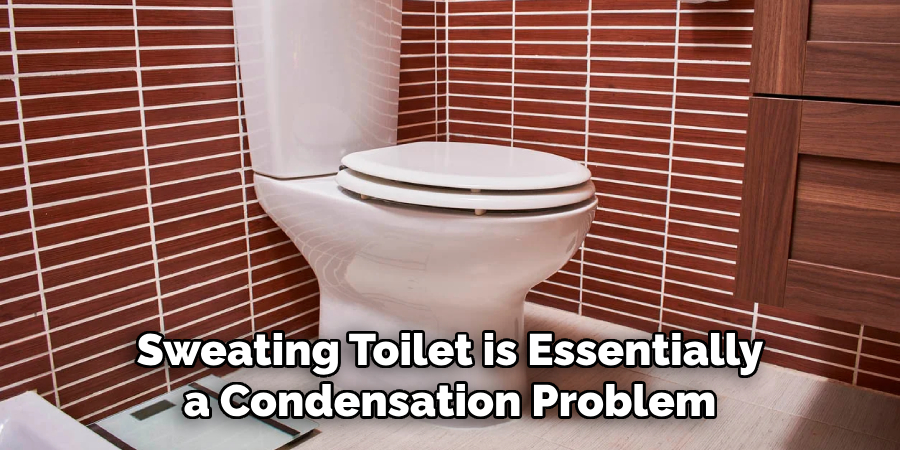
This phenomenon is more prevalent during the warmer months when the humidity levels inside homes tend to be higher. Additionally, activities such as hot showers can significantly increase the bathroom’s humidity levels, exacerbating the problem. Understanding this fundamental cause is crucial in addressing and mitigating the effects of a sweating toilet, paving the way for a drier and more comfortable bathroom environment.
Common Issues Associated with Sweating Toilets
Sweating toilets, while seemingly a minor inconvenience, can lead to a variety of problems within the home if not promptly addressed. One of the most immediate concerns is the risk of water damage. Persistent moisture can ruin flooring materials, whether it be warping hardwood floors or loosening adhesive under vinyl tiles. Over time, the excessive dampness may also cause paint and wallpaper to peel, further deteriorating the aesthetic appeal of your bathroom.
Another significant issue is mold and mildew growth. These fungi thrive in damp environments and can quickly colonize areas around a sweating toilet. Their presence not only mars surfaces with unsightly stains but can also emit unpleasant odors that permeate the bathroom space. More importantly, mold spores pose health risks, potentially leading to respiratory problems and allergic reactions among the occupants.
Furthermore, the constant wetness around the toilet base increases the likelihood of slips and falls, particularly concerning in households with young children or elderly family members. This safety hazard underscores the necessity of rectifying a sweating toilet problem before it leads to accidents.

Lastly, the inefficiency caused by a sweating toilet can lead to increased water usage. In attempts to mitigate the issue, some homeowners frequently wipe down the toilet or lay towels around its base, practices that, while temporarily solving the symptom, do not address the root cause and add to water and laundry loads. Understanding and tackling these common issues associated with sweating toilets are crucial steps towards maintaining a safe, healthy, and damage-free home environment.
10 Methods How to Fix a Sweating Toilet
1. Reduce Humidity Levels:
One of the primary causes of toilet sweating is high humidity levels in the bathroom. To address this issue, consider installing a bathroom exhaust fan or improving ventilation to help reduce moisture buildup in the air. Running the exhaust fan during and after showers can significantly lower humidity levels and minimize toilet sweating. Additionally, keep the bathroom door open while showering to allow steam to escape and prevent it from condensing on surfaces.
Another way to decrease humidity levels in the bathroom is by using a dehumidifier. This appliance works by pulling moisture out of the air, helping to keep humidity levels under control. It can be especially useful for older homes with poor ventilation systems.
2. Insulate the Toilet Tank:
Insulating the toilet tank is an effective way to prevent condensation from forming on its exterior surface. You can purchase pre-cut foam insulation kits designed specifically for toilet tanks or use a DIY solution such as foam pipe insulation. Wrap the insulation around the exterior of the tank, ensuring it covers the entire surface area to provide maximum insulation. Secure the insulation in place with tape or zipties.

Additionally, insulating your toilet tank can also help conserve energy and reduce your utility bills. By maintaining a consistent water temperature inside the tank, you can prevent your toilet from using extra energy to heat up cold water every time it is flushed.
3. Install a Toilet Tank Liner:
Another option for insulating the toilet tank is to install a tank liner. Tank liners are made of materials such as foam or rubber and are designed to create a barrier between the cold water inside the tank and the warm air outside.
Simply place the liner inside the tank according to the manufacturer’s instructions to help prevent condensation. This option is ideal for those who are looking for a more permanent solution and do not want to go through the process of regularly changing out insulation material.
Toilet tank liners can also help reduce noise coming from the toilet. The sound of water rushing into the tank can be quite loud, especially in older toilets. By installing a tank liner, you can decrease the noise level and make your bathroom experience more peaceful.
Additionally, tank liners can also help prolong the lifespan of your toilet. The constant exposure to moisture and condensation can cause rusting and corrosion in the tank, leading to potential leaks and damage over time. By insulating the tank with a liner, you can protect it from these damaging effects and potentially save yourself from costly repairs down the line.
4. Adjust the Room Temperature:
Fluctuations in room temperature can contribute to toilet sweating. To help mitigate this issue, consider adjusting the thermostat to maintain a consistent temperature in the bathroom. Keeping the room temperature slightly warmer can help prevent the toilet tank from becoming significantly colder than the surrounding air, reducing the likelihood of condensation.
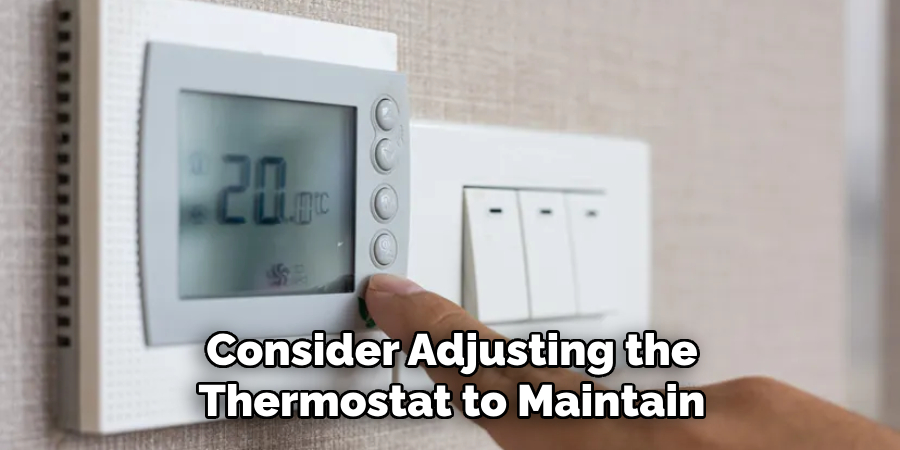
Additionally, proper insulation in the bathroom walls can help regulate the temperature and prevent drastic fluctuations. This can also provide energy-saving benefits by reducing the need for heating or cooling.
Other factors that can affect room temperature include location of windows, ventilation, and air flow. If possible, keep windows closed during high humidity days to prevent warm outside air from entering the bathroom and causing condensation. Additionally, make sure the bathroom is properly ventilated to prevent excess moisture from building up in the air. This can be achieved through the use of exhaust fans or opening windows after steamy showers.
5. Use a Toilet Tank Anti-Sweat Valve:
A toilet tank anti-sweat valve, also known as a mixing valve or tempering valve, can help regulate the temperature of the water entering the toilet tank. These valves mix hot and cold water to achieve a desired temperature, preventing the tank from becoming excessively cold and reducing condensation.
Install the valve according to the manufacturer’s instructions to effectively control sweating. However, there are some other benefits and uses of a toilet tank anti-sweat valve that you should know about.
6. Apply Anti-Condensation Coating:
Anti-condensation coatings are available for purchase and can be applied to the exterior surface of the toilet tank to help prevent condensation. These coatings create a barrier that reduces heat transfer between the tank and the surrounding air, minimizing the formation of moisture on the tank’s surface. Although this solution is effective, it is not a permanent fix and will need to be reapplied periodically.
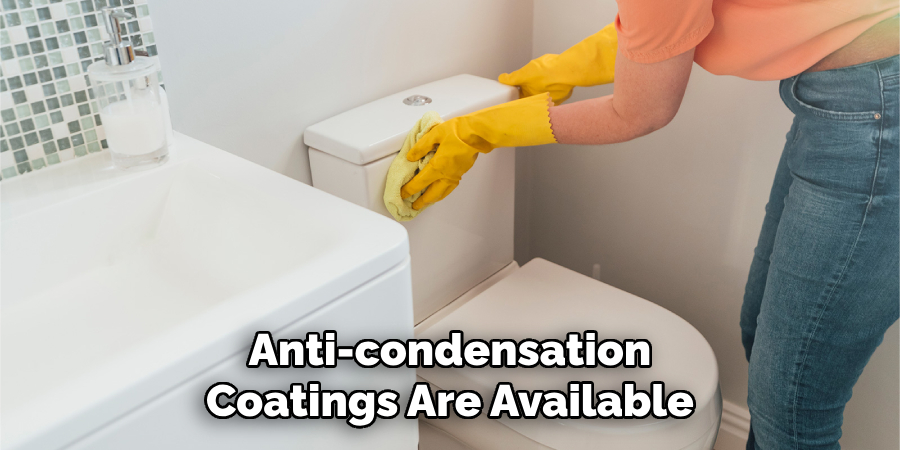
Another option for preventing condensation on your toilet tank is the use of insulation. Insulating materials, such as foam or fiberglass, can be placed between the wall and the tank to reduce heat transfer. This can help keep the surface of the tank at a similar temperature to the surrounding air, preventing condensation from forming.
In addition to external solutions, there are also internal remedies for condensation on toilet tanks. One option is to install a toilet tank liner, which creates a barrier between the inside of the tank and the outside environment. This can help regulate the temperature inside the tank and prevent condensation from occurring.
7. Use a Dehumidifier:
If high humidity levels persist in the bathroom despite ventilation efforts, consider using a portable dehumidifier to remove excess moisture from the air. Place the dehumidifier in the bathroom and run it regularly to help maintain optimal humidity levels and prevent toilet sweating. Dehumidifiers are also useful for preventing mold and mildew growth, which can thrive in moist environments.
Dehumidifiers work by drawing in humid air and passing it through a cooling coil that condenses the moisture. The condensed water is then collected in a tank or drained out of the unit. Before purchasing a dehumidifier, make sure to check its capacity and coverage area to ensure it is suitable for your bathroom size.
In addition to using a dehumidifier, there are other steps you can take to reduce moisture in the bathroom. These include repairing any leaks or cracks in pipes, fixing faulty ventilation fans, and wiping down surfaces after showering or bathing. You can also try using moisture-absorbing products such as silica gel packets or charcoal bags to help absorb excess moisture in the air.
8. Check for Leaks:
In some cases, toilet sweating may be caused by a leaking toilet tank or supply line. Inspect the tank and supply line for any signs of leaks, such as water puddles or dampness around the base of the toilet. If a leak is detected, repair or replace the affected components to prevent further moisture buildup and damage.

It’s also important to regularly check for leaks and address them promptly to avoid any potential water damage. Though toilets may seem like simple fixtures, they can cause significant problems if left unchecked.
9. Insulate Pipes:
In addition to insulating the toilet tank, insulating any exposed pipes in the bathroom can help prevent toilet sweating. Use foam pipe insulation or wrap the pipes with insulation tape to create a barrier against temperature fluctuations and reduce condensation formation. This can also help save energy by keeping hot water pipes insulated and reducing heat loss. While insulating pipes can be a bit more complex than insulating the toilet tank, it is worth the effort in the long run.
Insulating pipes in other areas of your home, such as the basement or crawl space, can also help prevent freezing and potential burst pipes during cold weather. This is especially important for homes in colder climates where temperatures drop below freezing frequently.
In addition to preventing condensation and potential damage, insulating pipes can also help improve water pressure. When hot water travels through uninsulated pipes, it cools down more quickly, causing weaker water pressure. Insulating these pipes can help maintain the temperature of the water and keep your showers nice and strong.
10. Monitor and Adjust:
After implementing one or more of the above methods to fix a sweating toilet, monitor the bathroom environment regularly to ensure that the issue has been effectively addressed. Make adjustments as needed, such as fine-tuning the thermostat settings or adding additional insulation, to maintain a dry and comfortable bathroom environment. Additionally, consider implementing preventative measures to prevent future sweating, such as installing a ventilation fan or using a dehumidifier.
Regular maintenance of the toilet itself can also help prevent sweating. Make sure to regularly clean and disinfect the toilet, including the tank and flushing mechanism. This will not only keep your bathroom more hygienic but can also help prevent any potential buildup or blockages that could contribute to sweating.
High Humidity Levels in The Bathroom Environment
High humidity levels in the bathroom can significantly contribute to the problem of a sweating toilet. Humidity is essentially the amount of water vapor present in the air, and bathrooms often have higher humidity due to activities like showering and bathing.
When warm, moist air comes into contact with the cooler surface of the toilet, condensation forms, leading to the phenomenon commonly referred to as “sweating.” To combat this issue, it’s crucial to manage the bathroom’s humidity levels effectively.
This can be achieved through proper ventilation, using exhaust fans during and after showers, and keeping the door or window open when possible to allow for air circulation. Additionally, minimizing the use of hot water in the bathroom can also help reduce humidity levels.
Ensuring Proper Installation for Maximum Effectiveness
To ensure that measures taken to reduce toilet sweating are maximally effective, it’s imperative to guarantee that all equipment and solutions are properly installed. This includes making sure that ventilation fans have enough capacity for your bathroom’s size and are correctly vented to the outdoors.
Similarly, if using a dehumidifier, choose a model that is appropriately sized for the bathroom to efficiently control humidity levels. For toilet tank insulation kits, follow the manufacturer’s instructions carefully to ensure a snug fit, which helps prevent condensation.
Proper installation is not only crucial for the immediate effectiveness of these measures but also for their longevity and durability. Consulting with professionals for installation can provide additional assurance that everything is set up correctly, preventing future issues and ensuring a comfortable bathroom environment.
Conclusion
In conclusion, tackling the issue of a sweating toilet is essential not only for maintaining a comfortable bathroom environment but also for preventing potential water damage and mold growth. By following the comprehensive guide outlined above, homeowners can address the root causes of sweating toilets and implement effective solutions to resolve the problem.
Whether it’s insulating the toilet tank, adjusting room temperature and humidity, or checking for plumbing leaks, taking proactive steps ensures a dry and comfortable bathroom experience. Additionally, incorporating prevention tips such as regular maintenance and monitoring of humidity levels helps to prevent future sweating issues and maintain optimal functionality.
Hopefully, this article gave you some helpful tips about how to fix a sweating toilet successfully, so now that you have the proper knowledge on how to get the job done, why not give it a try today?

